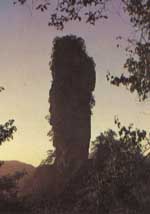Wulingyuan

Wulingyuan Scenic Area spreads out among Wulingyuan Mountains in Zhangjiajie city, southwest of Hunan province. It is about 400 kilometers (248.56miles) away from Changsha, the provincial capital. The whole area includes four parts: Zhangjiajie National Forest Park, Yangjiajie Scenic Spot, Suoxiyu and Tianzishan Natural Resources Reserves with an area of 500 square kilometers (193 square miles). Owing to the neighboring plateau southwesterly of it and Dongting Lake to the east, the second biggest fresh water lake of China, Wulingyuan Scenic Area comes into being under interaction of land elevation and depression and the cutting force of flowing water. It presents a unique landscape of high mountains, grotesque peaks, beautiful waters, deep gorges, marvelous caves and exuberant forest.
Long since, Wulingyuan was kept in oblivion because of being hidden in hinterland of the province. It was until 1979 that Mr. Wu Guanzhong, a famous Chinese painter, discovered this magic land. In 1992, UNESCO inscribed it Wulingyuan on World Heritage List.
 Zhangjiajie National Forest Park
Zhangjiajie National Forest Park
Zhangjiajie National Forest Park comes up as the first of its kind in China in 1982. It lies in the southwest part of Wulingyuan Scenic Area. There grow over 1000 kinds of plants with coverage of approximately 97.7% of the total area. Among them, the rarities are gingko, sequoia and Yunnan catalpa. It also provides a best homeland for hundreds species of vertebrates, like clouded leopard, tarpon, macaque, giant salamander, pangolin, etc. Its scenery is known for grotesque peaks. Three thousand sandstone peaks, posing in various ways, make up a forest of peaks and shape the land into a natural labyrinth. Eight hundred streams crisscross through the valley with springs and waterfalls interspersed all around.
Suoxiyu Natural Resource Reserve
The land of Suoxiyu marks transitional zone of sandstone and limestone area, so the mountains here are not as cragged as those in Zhangjiajie Park. They do not stand out solitary, but outstretch one after another, like an unfolding scroll of Chinese painting. Besides the peculiar peak and beautiful water, Suoxiyu has its distinct features in bridges and caves. Constructed upon steepy cliff, bridges are noted for their risky location. Most of them were merely piled up by blocks of rocks that dovetailed perfectly by human works. Meanwhile the limestone caves create fascinating underground palace. There are altogether 59 caves full of queerly and differently shaped stalactites and stalagmites.
Tianzishan Natural Resource Reserve
Tianzishan is located in the north of Wulingyuan area, bordering on the south with Zhangjiajie and joining Suoxiyu to the east. It offers a panoramic view due to its higher location than other areas. Its major peak rises 1250 meters (4101feet) above the ground.
Minorities
West of Hunan province, it boasts a rich and special minority culture. In Zhangjiajie city, there live more than 20 minority groups, like Tujia, Bai, Hui, Miao, etc. During the long-time evolvement of civilization, they bring out a set of customs and traditions of their own style, including living habits, funeral and marriage systems, religions, and arts. For example, the Hand-Shaking Dance of Tujia minority, the Drum Dance of Bai, dragon dance of Miao are most representative. Villages of Miao or Tu minority people can be seen with groups of amphibious storied-houses. This kind of house is usually built up of wood or bamboo and typical of the subtropical area in China, like Zhangjiajie, where the climate is subject to monsoon with annual average rainfall of 1.382 millimeters.













No comments:
Post a Comment